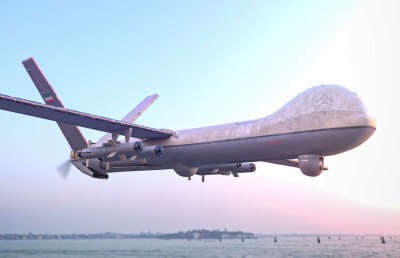Russia and Iran plan to build a new killer drone factory, a joint venture that will serve to restock Russia’s depleted supplies of the crucial weapon amid the raging Ukraine war.
The New York Times reported this month that the planned facility will be based in the Yelabuga region east of Moscow, with production scheduled to start in 2024 and a projected output of 6,000 drones over the next few years to support Russia’s war effort.
Russian ships currently transport Iranian drones from Amirabad in Iran, across the Caspian Sea, where they are unloaded at Makhachkala in Russia, according to the report.
From there, The New York Times report says that the drones are transported to two bases, one northeast of Ukraine and another east of the country, before being deployed to attack Ukrainian targets.
The New York Times report says that Russia’s plans to build a drone factory with Iranian assistance have been known since January 2021, with the White House declassifying sensitive satellite imagery to raise international pressure on Iran and help international businesses from unintentionally contributing to Iran’s attack drone program.
Indeed, an October 2022 report from the Institute of Science and International Security think tank says that parts from Germany, China, the US, Poland and Austria have been recovered from Iranian drone remnants in Ukraine.
The ISIS report mentions that the diversity of parts shows that Iran has established and cultivated an extensive procurement network aimed at bypassing sanctions imposed against it to obtain critical military technology.
The Ukraine war has exposed systemic weaknesses in Russia’s drone program. Asia Times noted in November 2022 that while Russia is funding multiple drone programs it has faced multiple challenges in getting them up to speed.
These challenges include an immature local drone industry, limited access to advanced technologies that have been exacerbated by Western sanctions and a scarcity of high-end systems cleared for operational use.
Those limitations have been witnessed in Russia’s technologically-challenged short-range tactical drones, which are unable to carry heavy payloads. Russia also lags in key drone technologies such as optics, electronics and composite materials, with conflicting requirements from the different branches of the Russian military reportedly impeding its drone program.
Building Iranian-origin drones – and possibly missiles – in Russia could help to overcome these challenges, analysts say.
Paul Iddon notes in a January 2023 article for Forbes that Iranian defense companies have already supplied components for more rapid construction of drones in Russia. Iddon says that continued drone deliveries have been possible because Russian factories have manufactured drones using Iranian parts.

Russia has also been upgrading its Iranian-origin Shahed-136 drones, boosting their resistance against electronic attack while increasing their lethality.
In a February 2023 Forbes article, Iddon notes that Russia has upgraded its Shahed-136 drones with multipurpose warheads that have been used against Ukraine’s energy infrastructure and semi-armor-piercing warheads that have been launched against hardened targets.
He also notes plans to upgrade the Shahed-136’s notoriously noisy gasoline engine with a silent electric motor, which may have already been done to maximize the drone’s chances of evading Ukrainian defenses.
Iran is also allegedly preparing to send ballistic missiles to Russia, although deliveries have not yet materialized.
In October 2022, Asia Times reported that Iran is preparing to send shipments of Fateh 110 and Zolfaghar short-range ballistic missiles (SRBM) with ranges of up to 300 and 700 kilometers to Russia.
Russia has been burning through its missile stocks since the start of the Ukraine war. Less-than-ideal use of surface-to-air and anti-ship missiles to hit ground targets have contributed to shortages of these advanced munitions.
Indeed, Breaking Defense reported in May 2023 that Russia has been firing cruise missiles mere weeks after production.
Recovered Kh-59MK2 air-to-surface missile remains in March 2023 apparently showed that the missile was manufactured in the fourth quarter of 2022. The remains of one Kh-101 missile recovered in November 2022 indicated that it was manufactured just a month before.
The Ukraine war has also exposed Russia’s surprising dependence on Western electronics for its missiles. Analysis of Russian 9M727 Iskander cruise missile remains showed it included microchips from German and US manufacturers.
Asia Times noted in August 2022 that while Russia can produce critical electronics for missiles, such as microchips, its underfunded semiconductor industry is 20 to 30 years behind the US and has been reduced to copying Western designs.
While Western sanctions have impeded Russia’s access to hi-tech chips for its missiles, Russia has reportedly acquired unknown quantities of these sensitive components through its secret services and transshipment through third countries.
Russia’s massive oil and gas revenues have also allowed it to finance more missile orders from its state-run factories, hire additional staff and increase working hours.

The new drone factory to be built outside of Moscow is seemingly part of Iran’s emerging drone diplomacy. Asia Times noted in May 2022 that Iran’s move to establish drone factories abroad could be part of its efforts to avoid international isolation, bypass international sanctions and build partnerships with client states.
Iran’s drone-related assistance to Russia reinforces their strategic partnership, which will be strengthened and expanded through the supply of spare parts, munitions, training, maintenance and technical assistance.
Some suggest that joint drone production may serve as a stopgap before Iran can deliver SRBMs to Russia. Iddon reports that Iran may still be gauging the likely international reaction if it delivers SRBMs to Russia, which may trigger international sanctions under UN Security Council (UNSC) Resolution 2231.
He notes that Iran may be biding its time until UNSC Resolution 2231 restrictions regarding missiles and related technology expires in October 2023.

